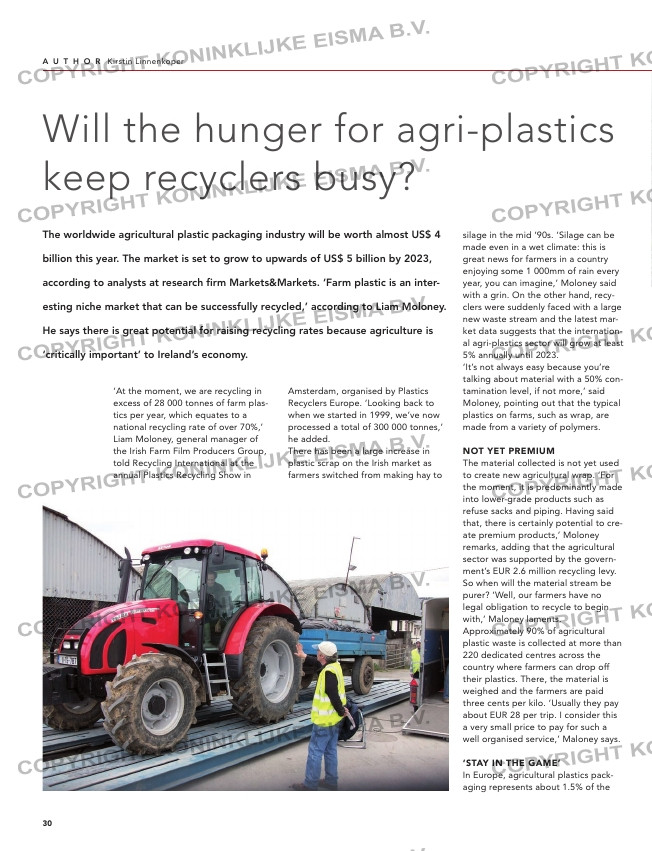Page 30 from: Summer issue 2018

Will the hunger for agri-plastics
keep recyclers busy?
The worldwide agricultural plastic packaging industry will be worth almost US$ 4
billion this year. The market is set to grow to upwards of US$ 5 billion by 2023,
according to analysts at research firm Markets&Markets. ‘Farm plastic is an inter-
esting niche market that can be successfully recycled,’ according to Liam Moloney.
He says there is great potential for raising recycling rates because agriculture is
‘critically important’ to Ireland’s economy.
total plastics waste stream. In the US,
agricultural plastics makes up around
2% of the annual waste stream of 32
million tons. Around 135 500 tonnes
of agricultural plastic waste is pro-
duced annually in the UK. The lion’s
share, 103 500 tonnes, represents
dirty or contaminated plastics.
‘Many plastics recyclers are talking
about the Chinese Sword import ban.
I’m afraid I have to report that the
trade restrictions have notably impact-
ed the recycling of agricultural plastics
in Ireland, and in Europe generally,’
Moloney points out. ‘All I can recom-
mend is: please stay in the game.
Shared responsibility is essential.’
NZ: 77% SAY AGRI-WASTE IS A
PROBLEM
On average, farms in New Zealand
produce around 10 tonnes of non-nat-
ural rural waste every year, according
to a study conducted by the
Environment Canterbury Regional
Council. The group, operating from
Christchurch, found more than 50 dif-
ferent types of material in this waste
stream, including tyres, baling wrap,
netting, feed bags, agrichemicals and
plastic containers. This waste can be
dropped off at 74 locations through-
out the country.
Nearly all (92%) of the farmers admit-
ted burning, stockpiling or burying a
sizeable portion of this waste in a farm
pit. In the Canterbury region alone,
this means that 192 000 tonnes of
these materials are thus disposed of
annually at more than 8 825 farms.
‘At the moment, we are recycling in
excess of 28 000 tonnes of farm plas-
tics per year, which equates to a
national recycling rate of over 70%,’
Liam Moloney, general manager of
the Irish Farm Film Producers Group,
told Recycling International at the
annual Plastics Recycling Show in
Amsterdam, organised by Plastics
Recyclers Europe. ‘Looking back to
when we started in 1999, we’ve now
processed a total of 300 000 tonnes,’
he added.
There has been a large increase in
plastic scrap on the Irish market as
farmers switched from making hay to
silage in the mid ‘90s. ‘Silage can be
made even in a wet climate: this is
great news for farmers in a country
enjoying some 1 000mm of rain every
year, you can imagine,’ Moloney said
with a grin. On the other hand, recy-
clers were suddenly faced with a large
new waste stream and the latest mar-
ket data suggests that the internation-
al agri-plastics sector will grow at least
5% annually until 2023.
‘It’s not always easy because you’re
talking about material with a 50% con-
tamination level, if not more,’ said
Moloney, pointing out that the typical
plastics on farms, such as wrap, are
made from a variety of polymers.
NOT YET PREMIUM
The material collected is not yet used
to create new agricultural wrap. ‘For
the moment, it is predominantly made
into lower-grade products such as
refuse sacks and piping. Having said
that, there is certainly potential to cre-
ate premium products,’ Moloney
remarks, adding that the agricultural
sector was supported by the govern-
ment’s EUR 2.6 million recycling levy.
So when will the material stream be
purer? ‘Well, our farmers have no
legal obligation to recycle to begin
with,’ Maloney laments.
Approximately 90% of agricultural
plastic waste is collected at more than
220 dedicated centres across the
country where farmers can drop off
their plastics. There, the material is
weighed and the farmers are paid
three cents per kilo. ‘Usually they pay
about EUR 28 per trip. I consider this
a very small price to pay for such a
well organised service,’ Maloney says.
‘STAY IN THE GAME’
In Europe, agricultural plastics pack-
aging represents about 1.5% of the
A U T H O R Kirstin Linnenkoper
30
30-31_agriplastics.indd 30 08-08-18 15:46



